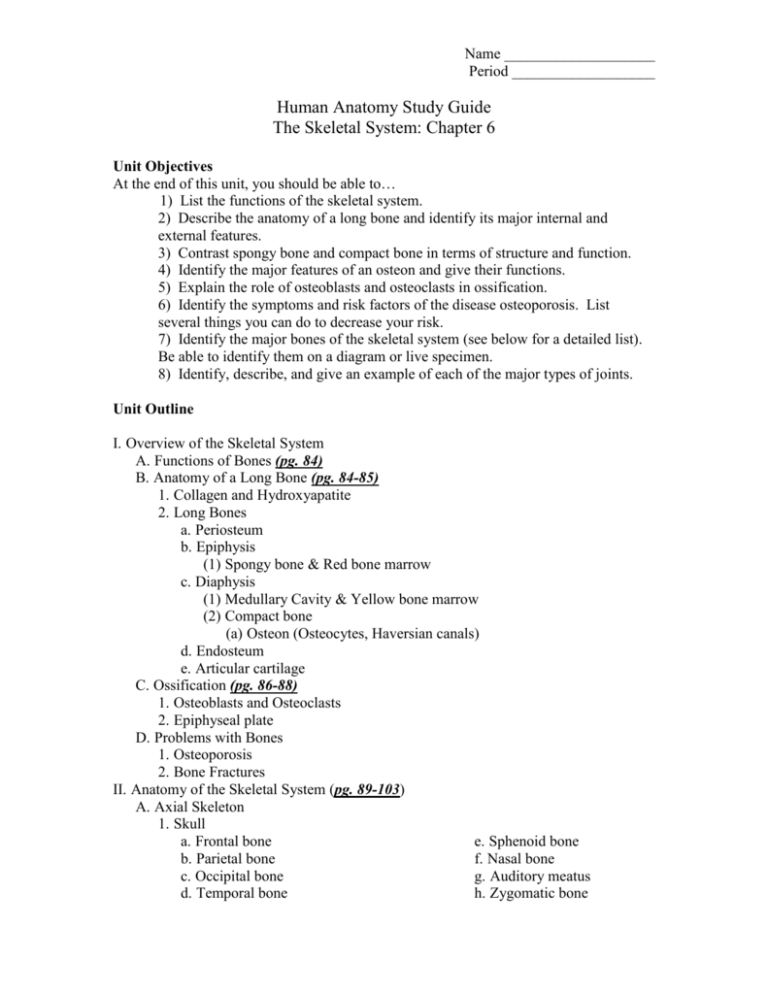Human Anatomy Study Guide The Skeletal System: Chapter 6
advertisement

Name ____________________ Period ___________________ Human Anatomy Study Guide The Skeletal System: Chapter 6 Unit Objectives At the end of this unit, you should be able to… 1) List the functions of the skeletal system. 2) Describe the anatomy of a long bone and identify its major internal and external features. 3) Contrast spongy bone and compact bone in terms of structure and function. 4) Identify the major features of an osteon and give their functions. 5) Explain the role of osteoblasts and osteoclasts in ossification. 6) Identify the symptoms and risk factors of the disease osteoporosis. List several things you can do to decrease your risk. 7) Identify the major bones of the skeletal system (see below for a detailed list). Be able to identify them on a diagram or live specimen. 8) Identify, describe, and give an example of each of the major types of joints. Unit Outline I. Overview of the Skeletal System A. Functions of Bones (pg. 84) B. Anatomy of a Long Bone (pg. 84-85) 1. Collagen and Hydroxyapatite 2. Long Bones a. Periosteum b. Epiphysis (1) Spongy bone & Red bone marrow c. Diaphysis (1) Medullary Cavity & Yellow bone marrow (2) Compact bone (a) Osteon (Osteocytes, Haversian canals) d. Endosteum e. Articular cartilage C. Ossification (pg. 86-88) 1. Osteoblasts and Osteoclasts 2. Epiphyseal plate D. Problems with Bones 1. Osteoporosis 2. Bone Fractures II. Anatomy of the Skeletal System (pg. 89-103) A. Axial Skeleton 1. Skull a. Frontal bone e. Sphenoid bone b. Parietal bone f. Nasal bone c. Occipital bone g. Auditory meatus d. Temporal bone h. Zygomatic bone Name ____________________ Period ___________________ i. Maxilla m. Styloid process j. Mandible n. Occipital condyles k. Mandibular fossa o. Foramen magnum l. Mastoid process 2. Vertebrae a. Types: Cervical, Thoracic, Lumbar, Sacral, Coccygeal b. Intervertebral disks c. Atlas and Axis 3. Ribs (false ribs and true ribs) 4. Sternum B. Appendicular Skeleton 1. Pectoral Girdle (2) Ischium a. Clavicle (3) Pubis b. Scapula b. Sacrum 2. Upper limbs c. Coccyx a. Humerus 4. Lower limbs b. Radius a. Femur c. Ulna b. Patella d. Carpals c. Fibula e. Metacarpals d. Tibia f. Phalanges e. Tarsals 3. Pelvic Girdle f. Metatarsals a. Coxal bone g. Phalanges (1) Ilium C. Parts of Bones 1. Head 5. Fossa 2. Condyles 6. Meatus 3. Process 7. Sinus 4. Foramen III. Joints (pg. 104-107) A. Fibrous joints B. Cartilaginous joints C. Synovial joints: Ball-and-socket joint, Pivot joint, Hinge joint D. Damage to Joints 1. ACL injury 2. Arthritis 3. Sprains 4. Dislocations Practice Problems 1. List and describe five functions of the skeletal system. Name ____________________ Period ___________________ 2. Describe the structure and/or function of each of the following parts of a long bone. Then label them on the diagram below: A) B) C) D) E) F) G) H) Spongy bone Diaphysis Yellow bone marrow Epiphysis Red bone marrow Medullary cavity Periosteum Articular cartilage 3. What is an osteon? What are the major components of an osteon? 4. Compare and contrast the following terms A) Epiphysis vs. Diaphysis B) Spongy bone vs. Compact bone C) Osteoblasts and Osteoclasts. D) Red bone marrow vs. Yellow bone marrow 5. A) Describe the role of the epiphyseal plate in bone growth. B) What changes occur that cause bones to stop growing during adolescense? Name ____________________ Period ___________________ 6. The figure below compares normal bone with bone affected by a disease called osteoporosis. A) What is osteoporosis? B) List several symptoms of osteoporosis. C) Why is it important to try to increase bone density while you are young? 7. Define and give an example of each of the following parts of bones. A) Head B) Condyle C) Foramen D) Meatus 8. Compare and contrast the following terms: A) Pectoral girdle vs. Pelvic girdle B) Atlas vs. Axis C) Humerus vs. Femur D) Radius vs. Ulna E) Carpals vs. Tarsals F) Sacral vertebrae vs. Lumbar vertebrae G) Maxilla vs. Mandible Name ____________________ Period ___________________ 9. The diagram below shows the vertebral column A) Label each of the following types of vertebrae on the diagram: Thoracic, Sacral, Cervical, Coccygeal, and Lumbar. B) Label the axis and atlas on this diagram. How are these two vertebrae different from other vertebrae? C) Label and describe the role of intervertebral disks. D) When one of the intervertebral disks ruptures, it is called a herniated disk. These often need to be removed surgically. When this is done, the two vertebrae surrounding the disk are often fused together. Explain why this is necessary based on your understanding of the function of intervertebral disks. 10. A) What three bones make up the pelvis? B) List several differences between the pelvis of a male and the pelvis of a female. Name ____________________ Period ___________________ 11. A) Label each of the following terms on the skull diagram. 1. Frontal bone 2. Nasal bone 3. Zygomatic arch 4. Parietal bone 5. Maxilla 6. Mandible B) Inferior to the teeth, there are two small holes, one on either side of the lower jaw. What is the name for holes in the bone such as these? What might the purpose of these holes be? C) The skull is made up of many different bones. What type of joints hold these bones together? What adaptive value is there in having many small bones make up the skull? Hint: Think fetal! 12. The diagram below shows a human skeleton. Identify each of the following bones on the diagram. A) Scapula B) Ulna C) Humerus D) Femur E) Tibia F) Tarsals G) Radius H) Metacarpals I) Phalanges J) Clavicle K) Coxal bone 13. Give an example of each joint: A) Pivot B) Hinge C) Ball and socket







